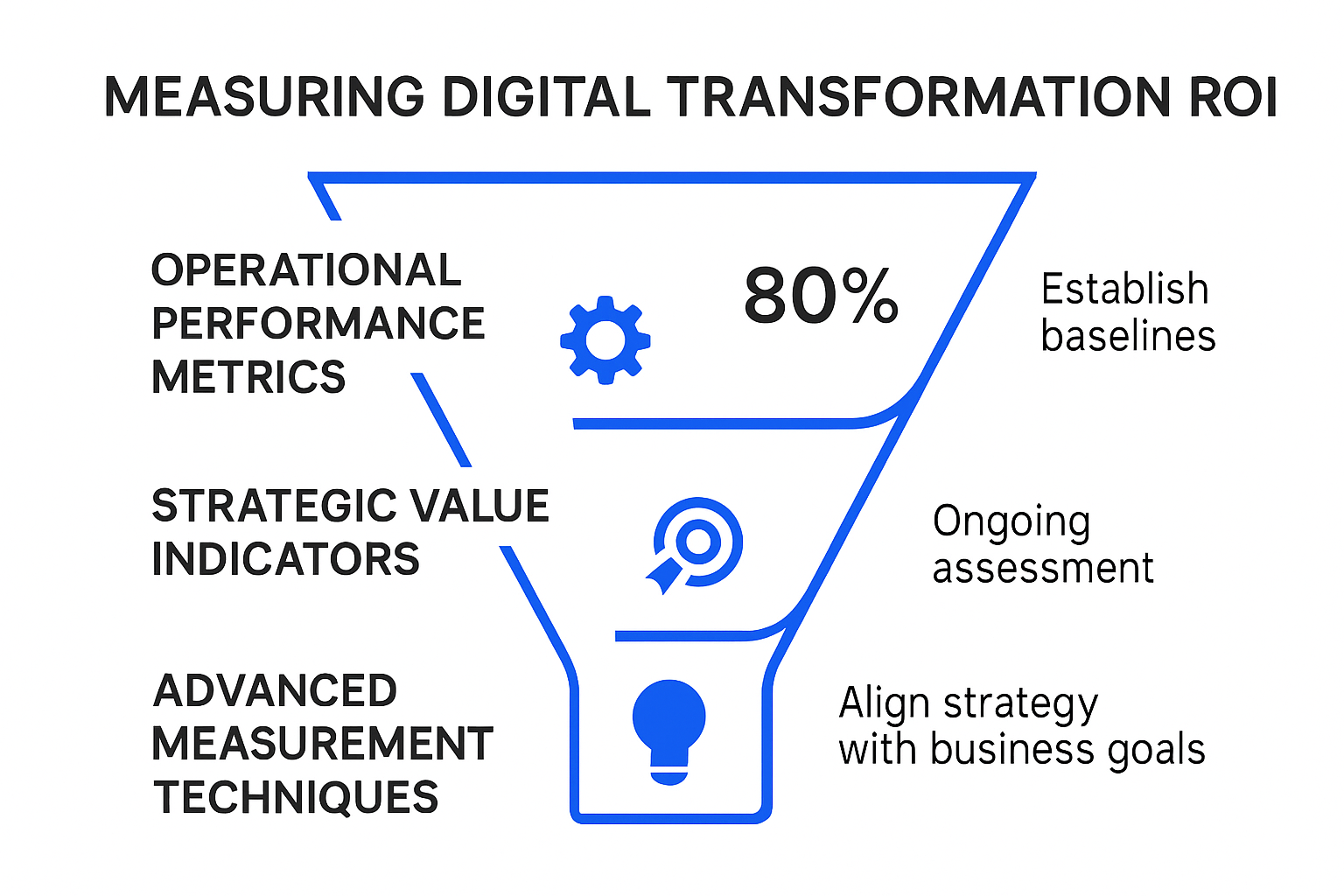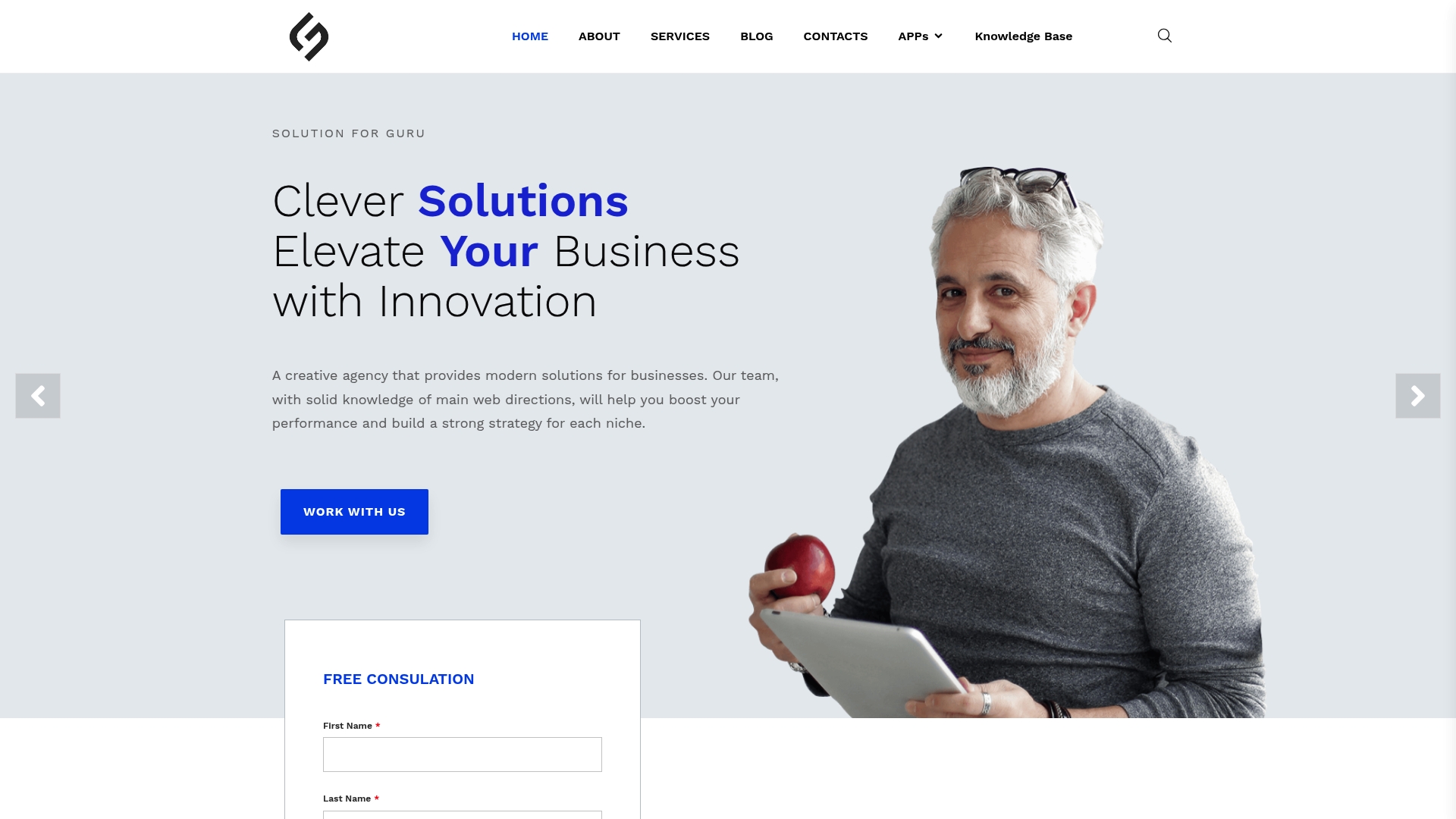Maximizing Digital Transformation ROI: A Step-by-Step Guide

Digital transformation promises big returns for companies chasing efficiency and growth. You might expect the real win comes down to profit margins and budget cuts. Yet studies show that process times can drop by up to 3.76 percent while productivity goes up by nearly 4.5 percent and the true measure of success stretches far wider than dollars and cents. The smartest businesses are unlocking value from faster learning, happier customers, and innovation that competitors simply cannot match.
Table of Contents
- Understanding Digital Transformation ROI
- Key Metrics to Measure ROI Effectively
- Best Practices to Maximize ROI Outcomes
- Overcoming Challenges in ROI Measurement
Quick Summary
| Takeaway | Explanation |
|---|---|
| Understand ROI Beyond Dollars | Digital transformation ROI includes operational efficiency, customer experience, innovation, and competitive positioning, not just financial returns. |
| Develop a Comprehensive Measurement Framework | Utilize both quantitative and qualitative metrics to assess the full impact of digital initiatives on your organization’s capabilities. |
| Align Digital Strategy with Business Goals | Establish a clear vision and incremental steps to connect transformational investments with broader organizational objectives, enhancing overall value. |
| Focus on Continuous Improvement | Regularly validate your technology investments by adapting strategies based on performance assessments every 6 to 12 months. |
| Address Measurement Challenges Rigorously | Implement advanced analytics and collaborative frameworks to tackle the complexities of accurately measuring digital transformation outcomes. |
Understanding Digital Transformation ROI
Digital transformation represents a strategic investment that goes far beyond simple technological upgrades. At its core, return on investment (ROI) for digital transformation measures the financial and strategic value generated from technology-driven organizational changes. Understanding this metric requires a comprehensive approach that evaluates both tangible and intangible benefits.
Defining Digital Transformation ROI
The concept of digital transformation ROI extends well beyond traditional financial calculations. According to research from the U.S. Government Accountability Office, successful digital transformation ROI involves carefully linking technological investments to specific organizational goals and measuring outcomes across multiple dimensions. This approach requires businesses to look beyond immediate monetary returns and consider long-term strategic advantages.
Key components of digital transformation ROI include:
To help readers compare and understand the dimensions of digital transformation ROI, the following table summarizes key components and what they measure within the organization.
| Key ROI Component | What It Measures |
|---|---|
| Operational Efficiency | Productivity gains, cost reductions |
| Customer Experience | Improvements in engagement and satisfaction |
| Innovation Capacity | Ability to develop new services or business models |
| Competitive Positioning | Strategic advantages gained in the market |
- Operational Efficiency: Measuring productivity gains and cost reductions
- Customer Experience: Evaluating improvements in customer engagement and satisfaction
- Innovation Capacity: Assessing the organization’s ability to develop new services or business models
- Competitive Positioning: Understanding how digital investments create strategic advantages
Measuring Comprehensive Value
Harvard Business School research highlights the importance of a holistic approach to calculating digital transformation ROI. Organizations must develop robust measurement frameworks that capture both financial metrics and strategic improvements. This means going beyond simple cost savings to understand how digital investments transform business capabilities.
The measurement process typically involves:
- Establishing clear baseline metrics before digital transformation
- Tracking both quantitative financial indicators
- Monitoring qualitative strategic improvements
- Conducting ongoing assessments to validate investment outcomes
Businesses seeking to maximize their digital transformation ROI must adopt a nuanced perspective that balances immediate financial returns with long-term strategic potential. Learn more about strategic digital transformation benefits to gain deeper insights into how technology investments can drive comprehensive organizational growth.
Ultimately, digital transformation ROI is not about a single number but a holistic understanding of how technology enables business evolution. Successful organizations view these investments as strategic opportunities to reimagine their operational models, enhance customer experiences, and create sustainable competitive advantages.
Key Metrics to Measure ROI Effectively
Measuring digital transformation ROI requires a sophisticated approach that goes beyond traditional financial metrics. Organizations must develop a comprehensive framework that captures both quantitative and qualitative indicators of digital investment success.
Operational Performance Metrics
Research from the OECD highlights the critical importance of establishing clear, measurable performance indicators. These metrics help organizations track the tangible impact of digital transformation initiatives. Key operational performance metrics include:
The following table presents the core operational performance metrics discussed in the article and highlights their primary focus in measuring digital transformation ROI.
| Metric | Focus |
|---|---|
| Process Efficiency | Time and resource consumption reductions |
| Productivity Improvements | Output increases and workflow optimizations |
| Cost Reduction | Direct financial savings from digital implementation |
| Technology Adoption Rates | Internal and external technology integration |
- Process Efficiency: Measuring reductions in time and resource consumption
- Productivity Improvements: Quantifying output increases and workflow optimizations
- Cost Reduction: Tracking direct financial savings from digital implementations
- Technology Adoption Rates: Assessing internal and external technology integration
Strategic Value Indicators
According to the Global Center for Digital Business Transformation, digital transformation ROI extends beyond immediate financial returns. Strategic value indicators provide insights into long-term organizational capabilities:
- Customer Experience Enhancement: Measuring improvements in engagement and satisfaction
- Innovation Capacity: Tracking the organization’s ability to develop new services
- Competitive Positioning: Evaluating market responsiveness and adaptability
- Workforce Engagement: Assessing employee productivity and technological empowerment
Advanced ROI Measurement Techniques
The Defense Acquisition University emphasizes the importance of developing quantifiable, predictable, and observable results. Advanced measurement techniques involve:
- Establishing baseline metrics before digital transformation
- Creating comprehensive tracking systems
- Implementing continuous assessment frameworks
- Developing predictive analytics models
Learn more about calculating marketing ROI to gain deeper insights into advanced measurement strategies.
Successful digital transformation ROI measurement requires a holistic approach that balances immediate financial outcomes with strategic long-term value. Organizations must move beyond traditional metrics to understand how digital investments fundamentally transform business capabilities, create new opportunities, and drive sustainable competitive advantages.

Best Practices to Maximize ROI Outcomes
Maximizing digital transformation ROI requires a strategic approach that goes beyond technology implementation. Organizations must develop comprehensive practices that align technological investments with broader business objectives and create sustainable value.
Strategic Alignment and Change Management
Research from MIT Sloan School of Management reveals critical strategies for leaders seeking to enhance digital transformation value. The key is becoming expert change managers who can effectively link foundational knowledge with practical implementation.
Essential strategic alignment practices include:
- Clear Vision Development: Establishing a comprehensive digital transformation roadmap
- Organizational Skill Assessment: Identifying and addressing capability gaps
- Incremental Implementation: Breaking down transformation into manageable stages
- Stakeholder Engagement: Ensuring cross-functional support and commitment
Optimization and Technology Integration
The Defense Acquisition University emphasizes that combining digitalization with strategic optimization can yield significant performance improvements. Their research indicates potential gains including:
- Reducing process times by up to 3.76%
- Increasing organizational output by approximately 4.48%
- Enhancing operational efficiency through targeted technological interventions
- Creating measurable performance benchmarks
Continuous Improvement and Risk Management
The U.S. Government Accountability Office recommends an incremental development approach to minimize investment risks. This involves delivering functional improvements every 6 to 12 months, allowing organizations to:
- Validate technological investments continuously
- Adapt strategies based on real-world performance
- Minimize potential implementation risks
- Maintain flexibility in digital transformation efforts
Explore advanced marketing ROI strategies to gain deeper insights into maximizing digital investment outcomes.
Successful digital transformation is not a one-time event but a continuous journey of strategic adaptation. Organizations must remain agile, continuously assess their digital initiatives, and maintain a holistic view of how technology investments create long-term value across operational, strategic, and competitive dimensions.

Overcoming Challenges in ROI Measurement
Digital transformation ROI measurement presents complex challenges that require sophisticated strategies and nuanced approaches. Organizations must develop robust frameworks to accurately capture the multifaceted value of technological investments.
Complexity of Value Attribution
McKinsey research highlights the intricate challenge of linking financial outcomes directly to digital initiatives. The complexity arises from interconnected business environments where technological interventions produce indirect and long-term impacts that traditional measurement approaches struggle to quantify.
Key challenges in value attribution include:
- Indirect Impact Measurement: Tracking non-linear value creation
- Multi-Dimensional Returns: Capturing strategic and operational benefits
- Temporal Complexity: Understanding short-term versus long-term value generation
- Cross-Functional Interactions: Assessing technology’s impact across different organizational domains
Technological and Organizational Barriers
Professional services firm Deloitte emphasizes that ROI measurement challenges often stem from technological limitations and organizational resistance. Successful measurement requires breaking down traditional silos and developing adaptive measurement frameworks that can evolve with technological advancements.
Strategic approaches to overcome these barriers include:
- Implementing advanced analytics and machine learning tools
- Creating cross-functional measurement teams
- Developing flexible, iterative assessment methodologies
- Investing in continuous skills development
- Establishing transparent communication channels
Emerging Measurement Frameworks
According to research from Gartner, next-generation ROI measurement requires a holistic approach that integrates qualitative and quantitative metrics. This involves:
- Developing predictive analytics models
- Creating dynamic value assessment tools
- Establishing real-time performance tracking mechanisms
- Integrating stakeholder feedback loops
- Maintaining adaptive measurement strategies
Explore advanced marketing ROI calculation techniques to gain deeper insights into sophisticated measurement approaches.
Successful digital transformation ROI measurement is not about finding a perfect formula but about creating a flexible, comprehensive framework that evolves with organizational needs. Organizations must remain agile, continuously refine their measurement approaches, and maintain a balanced perspective that recognizes both tangible financial returns and strategic long-term value creation.
Frequently Asked Questions
What is digital transformation ROI?
Digital transformation ROI measures the financial and strategic value generated from technology-driven changes within an organization. It encompasses both tangible benefits like cost savings and intangible advantages such as improved customer satisfaction and innovation capacity.
How can organizations measure the comprehensive value of digital transformation?
Organizations can measure comprehensive value by establishing clear baseline metrics, tracking both quantitative financial indicators and qualitative strategic improvements, and conducting ongoing assessments to validate outcomes.
What key metrics should be used to measure digital transformation ROI?
Key metrics include operational performance metrics such as process efficiency, productivity improvements, and cost reduction, along with strategic value indicators like customer experience enhancement and innovation capacity.
What best practices can help maximize ROI from digital transformation initiatives?
To maximize ROI, organizations should align their digital strategy with business goals, implement continuous improvement practices, ensure effective change management, and adopt advanced analytics for ongoing assessment of digital investments.
Unlock the Real ROI of Your Digital Transformation
You already know that achieving digital transformation ROI is about more than cutting costs. The article outlined how the real value comes from improved efficiency, strategic advantages, and a customer experience that sets you apart. But getting there is often harder than it looks. Many leaders struggle to connect technology investments to true business results, or find that process bottlenecks and a lack of integration hold back their big ideas.

Ready for faster innovation, higher productivity, and measurable business results? At Solution4Guru.com, our experts help you align web development, automation, AI integration, and digital marketing with your biggest goals. We build tailored strategies that deliver on every dimension of digital ROI. See our proven approaches and real impact by exploring our case studies and request your free consultation today. Make your next digital investment count—start transforming your business now.



